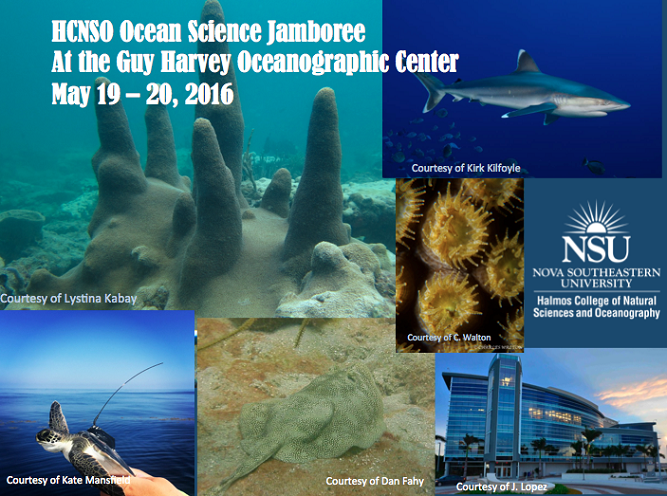The Seascape of the Southeast Florida Reef Tract: Life on a Marginal Reef
Location
Guy Harvey Oceanographic Center Facility
Start
5-20-2016 3:30 PM
End
5-20-2016 3:45 PM
Abstract
The southeast Florida Reef Tract spans approximately 170 km along a latitudinal gradient of southeast Florida coastline from Miami (25.5°) to St. Lucie River (27.25°) consisting of a diverse coral reef community. In this area, terrestrial climate regimes shift from southern warmer subtropical to cooler temperate in the north, pinning the reef tract at the margin of where coral reefs and tropical marine communities can exist. As climate has warmed, other marginal reef locations in the world have witnessed the range expansion of tropical species into historically more temperate areas. This does not appear to have happened or be happening in southeast Florida due to local upwelling which is affecting fish and benthic distributions. Six coral reef ecosystem regions have been defined along the coast where these changes occur and are corroborated by different analyses. In the southern region, mapping has uncovered some previously-unknown, exceptional corals threatened under the Endangered Species Act residing on nearshore hard-bottom habitats shallower than 10 m close to anthropogenic threats. Thirty-five locations of dense Acropora cervicornis were found exceeding over 156,000 m², only seven of which were previously reported, thus tripling the amount of known area. This is the largest amount reported in the continental United States. Additionally, 115 live stony corals greater than 2 m were identified (8 larger than 4 m), making them some of the oldest south Florida residents. The majority of corals were Orbicella sp. (80%). Corals were found between 4.6 m and 8.8 m (x̄ = 6.4 m) depth predominantly in the nearshore hard-bottom habitats. Most were spatially clustered into discrete areas along the coast. A thermal stress and disease event over the past two years has killed millions of corals, including one of the oldest corals and some large dense Acropora patches. The upwelling in our region seems to inhibit corals from escaping the heat along the eastern US seaboard as climate shifts. Perhaps they will wind up in Bermuda?
Presenter(s) Biography
Dr. Brian Walker can be contacted at walkerb@nova.edu
For a list of his publications, please click here.
The Seascape of the Southeast Florida Reef Tract: Life on a Marginal Reef
Guy Harvey Oceanographic Center Facility
The southeast Florida Reef Tract spans approximately 170 km along a latitudinal gradient of southeast Florida coastline from Miami (25.5°) to St. Lucie River (27.25°) consisting of a diverse coral reef community. In this area, terrestrial climate regimes shift from southern warmer subtropical to cooler temperate in the north, pinning the reef tract at the margin of where coral reefs and tropical marine communities can exist. As climate has warmed, other marginal reef locations in the world have witnessed the range expansion of tropical species into historically more temperate areas. This does not appear to have happened or be happening in southeast Florida due to local upwelling which is affecting fish and benthic distributions. Six coral reef ecosystem regions have been defined along the coast where these changes occur and are corroborated by different analyses. In the southern region, mapping has uncovered some previously-unknown, exceptional corals threatened under the Endangered Species Act residing on nearshore hard-bottom habitats shallower than 10 m close to anthropogenic threats. Thirty-five locations of dense Acropora cervicornis were found exceeding over 156,000 m², only seven of which were previously reported, thus tripling the amount of known area. This is the largest amount reported in the continental United States. Additionally, 115 live stony corals greater than 2 m were identified (8 larger than 4 m), making them some of the oldest south Florida residents. The majority of corals were Orbicella sp. (80%). Corals were found between 4.6 m and 8.8 m (x̄ = 6.4 m) depth predominantly in the nearshore hard-bottom habitats. Most were spatially clustered into discrete areas along the coast. A thermal stress and disease event over the past two years has killed millions of corals, including one of the oldest corals and some large dense Acropora patches. The upwelling in our region seems to inhibit corals from escaping the heat along the eastern US seaboard as climate shifts. Perhaps they will wind up in Bermuda?


